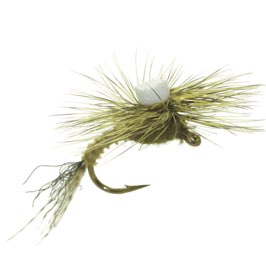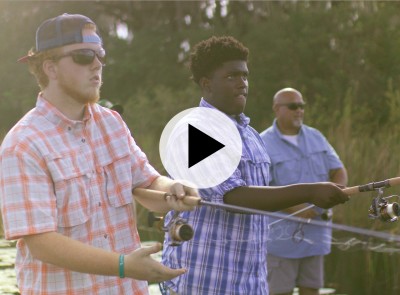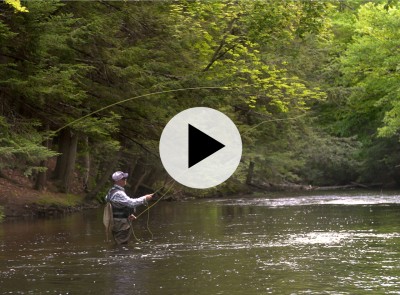(SPEECH)
[00:00:00.00] [MUSIC PLAYING]
(DESCRIPTION)
[00:00:00.50] A giant boot sits at the entrance of LL Bean. Text, Catching On with Ryan and Janice. How to Pick the Right Fly presented by LL Bean. Janice O'Rourke.
(SPEECH)
[00:00:10.19] We are going to answer some questions that you have today around fly fishing. I'm a complete novice. You might be as well.
[00:00:16.83] So we are going to talk to the man, the myth, the legend, Ryan Pappas at the Hunt Fish Store at L.L.Bean. He's going to help us out today, particularly around how do you choose the right fly for fly fishing. There are so many of them.
[00:00:30.26] Ryan, help us out, please.
[00:00:32.03] I am so happy you came in to see us because choosing the right fly is one of the most-asked questions we get in our store. There's going to be two flies that we'll recommend. One's above the surface, what we call a dry fly. And the other one is a below the surface, which is going to imitate things like nymphs or streamers.
[00:00:51.98] OK.
[00:00:52.85] Before we even get into this, we're going to talk about being observant of your environment. You want to see, are there flies landing on the surface? Do you see fish rising? Do you see the ripples in the water from where fish are feeding? It's going to be important.
[00:01:07.17] If you don't see any activity going on on the surface, you may want to go up to the water. Flip over a few rocks that are under the water, you'll see some bugs under there. We'll see some nymphs. We'll have all different sorts of insects that are living in that area.
[00:01:19.56] And it's important that we know what's living in that area so that you can match the hatch. OK?
[00:01:24.18] Match the hatch.
[00:01:25.53] When you match the hatch, you're imitating the fish's natural bait source at that exact period in time. So you're going to increase your odds exponentially of catching fish just because you're matching what they're actually eating.
[00:01:38.64] Awesome.
[00:01:39.09] All right.
[00:01:39.45] OK.
[00:01:39.87] Now let's talk about our two favorite flies here. The first one is going to be the Adam's dry fly. This is probably the most broad appealing mayfly variation, which is going to help you catch the most fish.
[00:01:52.26] That's good.
[00:01:52.80] So when we say dry fly, it's usually drifting in the current, and you're seeing a fish rise to eat it. And it's that instant gratification of my fly just got taken. I have a fish on, time to reel them in.
[00:02:05.40] I want that, Ryan.
[00:02:06.24] But fish only feed like that on the high side 20% to 30% of the time is what we're finding, especially with trout, OK. Most of the trout are going to feed below the surface.
[00:02:16.17] Oh. So this will not do the trick?
[00:02:18.30] That will not do the trick. So we're going to want to cover the below the surface for you. And that is where our next fly, the woolly bugger, comes in.
[00:02:25.99] So this one feels a little different.
[00:02:28.71] It's heavier.
[00:02:29.22] It's going to be a little heavier because it's actually going to sink below the surface. It's going to imitate tons of different things under the surface depending on the color variation and the size. It could be anything from a leech, to a bait fish, to a larger nymph. They're extremely versatile, and that's why we like to fish them.
[00:02:47.49] So this one fly can imitate the things you've just said?
[00:02:49.35] All those things.
[00:02:49.83] All of those things.
[00:02:50.46] And more.
[00:02:51.69] Awesome. Can we see what it looks like? How it imitates all those things you just said?
[00:02:55.86] Absolutely. So this tank is going to imitate a woolly bugger in the current as it picks up.
[00:03:00.63] I love like her little hair floating in the water.
[00:03:03.60] Yeah. So does the fish. It's a great fly to have in your arsenal, whether you're an expert or you're just beginning.
[00:03:09.07] Thank you so much for today. This was incredibly helpful. I hope you learned a lot. I learned a lot. And now, Ryan and I are going to go put this woolly bugger to work.
(DESCRIPTION)
[00:03:17.47] Ryan and Janice turn away from the camera and walk through the store. LL Bean. Be an Outsider.
(SPEECH)
[00:03:17.79] [MUSIC PLAYING]
[00:03:19.59]


















